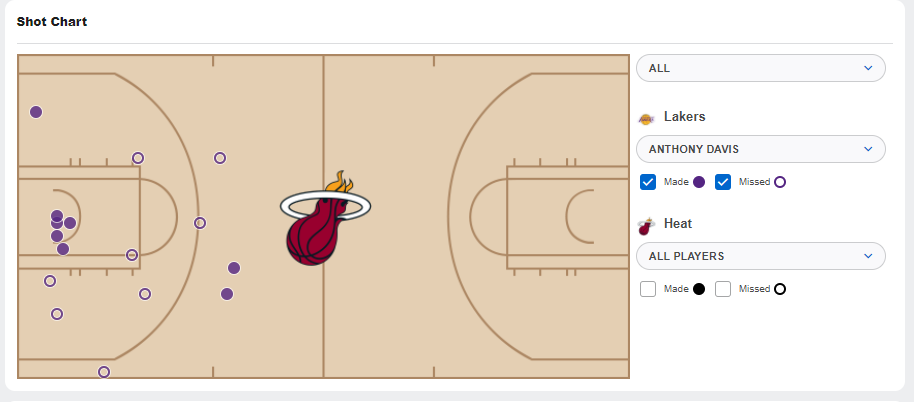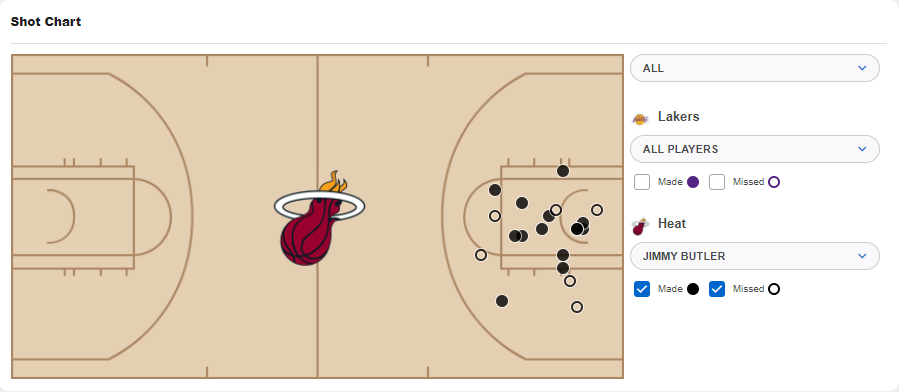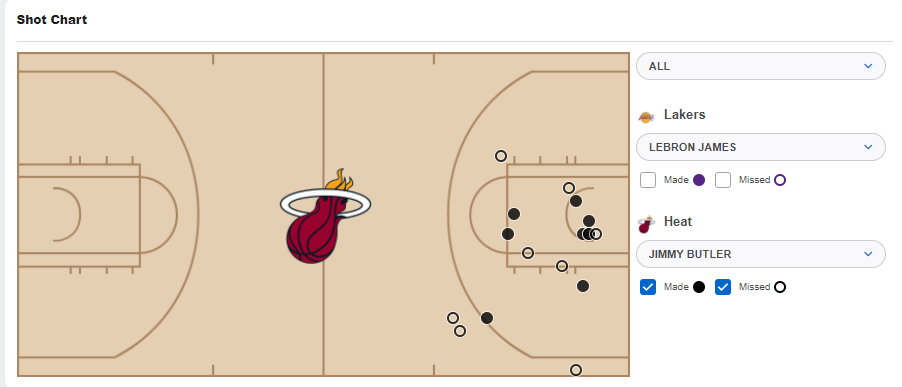-
October 7, 2020, 2:55 pm
Last Updated on October 7, 2020 4:42 pm by Nathan Nguyen | Published: October 7, 2020
Finals Game 4 Recap
As expected, the Heat put up another great fight in Game 4, but the Lakers prevailed thanks to their elite team defense. Obviously you’re going to get a lot from LeBron James (28-12-8) and Anthony Davis (22-9-4 with 4 blocks) but when the game was on the line, it was Kentavious Caldewell-Pope (15 points, three boards, five dimes and three triples) who came up clutch. The defining moments in this game happened late in the fourth when Jimmy Butler (22 points, 10 rebounds, nine dimes, three steals and a block) missed an open 3-pointer in the right corner and on the ensuing possession, KCP drilled a three-pointer after receiving a dime pass from James. When Butler took his shot, the Heat were down 88-90, but now the game was 93-88 in favor of the Lakers. The Lakers then forced a shot clock violation on the Heat on the defensive end and with Lebron James being double teams, it was KCP again who found himself at the top of the key with the ball, driving into the lane and converting on a tough layup that would put the Lakers up seven points, which was the largest lead in the game at the time, one that the Lakers would hold onto until the final buzzer.
Those moments are what create champions and although the Heat are not out of this series yet, the Lakers took care of business and made the right adjustments to counter what Miami did in Game 3. Coach Vogel saw the doubling of AD in the post and as expected, has sent more back cutters to take advantage of an open lane towards the basket and the Lakers hit that pass more often than they did in Game 3. He also posted up LeBron James more to get him into 1-on-1 matchups against Miami’s weaker defenders in Tyler Herro and Duncan Robinson. Although the Heat have prioritized taking away the paint, they’re also committed to not giving up open 3-point looks. This means that the mid-range portion of the floor is open for players like James and Davis to operate in 1-on-1 scenarios. James still committed six turnovers, but he and Davis had a lot more breathing room on the offensive end of the floor to create plays for their teammates and this led to open drives and looks for players like Kentavious Caldwell-Pope.
On the defensive side of the ball, you can describe the Lakers performance in two words, “Anthony Davis.” He was an absolute terror on the court and his four blocks had a huge impact on this game. He also had a a numerous amount of plays where he altered shots or just completely deterred the Heat’s players from even attempting a shot. His presence and activity on that end of the floor were clearly felt by the Heat players as they found it difficult to even get field goal attempts off. The Lakers are trying their best to get Davis to switch onto Jimmy Butler as he can deny easy looks in the paint and still close out on 3-point shooters quick enough with his speed and length to bother them. Miami shot 32 3-pointers compared to the Lakers’ 39 attempts. If you’re going to beat the Lakers, you need to get more 3-point attempts and get clean attempts as well and the Lakers did a phenomenal job preventing Miami from chucking up triples.
The heat still have a recipe that works for them on defense and I expect Coach Spo to continue to clog the paint and try to chase the Lakers’ shooters off the 3-point line. Holding the Lakers to 102 points is a commendable feat, but they don’t have the talent to make many mistakes. They’ll have to continue executing at near perfection, but I like the gameplan that’s put in place to slow down Davis and James. They have real issues on the offensive side of the ball though, as the Lakers have found something that works with Davis sticking on Butler and the team as a whole is doing a great job limiting the Heat’s 3-point attempts. Coach Spo will most likely come out with some wrinkles on offense to give his team some extra looks from deep, but at the end of the day, you’re going to have to solve the puzzle that is Anthony Davis on the defensive end of the floor. His defensive versatility is shining in this series.
Mid-Range Madness
There has been a lot of discussion around the mid-range shot and a weird war against analytics due to this. In the playoffs, the mid-range shot becomes more important than ever as teams try to deny either the paint or the 3-point line. There are different “types” of mid-range shots though and a clear example of this would be to look at how Anthony Davis and Jimmy Butler get their buckets.
Take a look at Anthony Davis’ shot chart in Game 4. His only mid-range make was a 17-footer. Now, the context of that 17-footer was huge. The Heat did everything in their power to deny AD easy post-ups and forced him to catch the ball far from the paint. On that shot, AD had the ball with maybe two seconds left on the shot clock and drilled a fadeaway bomb to extend the Lakers’ lead to five late in the third quarter. In a game of such slim margins, hitting those shots is the difference between being a champion and second place. He’s been making tough middies with the shot clock winding down the entirety of the playoffs, but that wasn’t the case in the regular season. His efficiency from the mid-range has spiked during the playoffs. In the regular season, he shot 35% from that area and in the playoffs, that number has increased to 51%. The mid-range shot is not dead by any means, especially in the playoffs.

Jimmy Butler had one of the best finals performances in NBA history, scoring and assisting on 73 points for this team, the most since Walt Frazier in 1970. There is a lot of hooplah around the fact that Butler didn’t attempt a single 3-pointer and people are now anointing him as the Mid-Range Messiah, but these people are creating a narrative that shouldn’t exist. The reason that the Heat found so much success with Butler in Game 3 was because they were able to surround him with four shooters and have him drive into the paint on the same side Duncan Robinson was on. This meant that the Lakers couldn’t help off and double team him. Coach Vogel also had his team constantly switch and go under the screens on Butler to make him shoot mid-range shots, but Miami’s counter was to set screens even lower than the 3-point line. This meant that Butler would get floaters, which are still mid-range shots, but they aren’t the 20-foot Carmelo Anthony jumpers that most people are painting them out to be. Take a look at Butler’s Game 3 shot chart here:

Butler’s furthest shots made were an 18-footer and a 16-footer. The average distance of his mid-range shots made was a whopping 11 feet. For reference, the free-throw line is 15 feet from the basket. Those two shots made just outside of the restricted area were actually layups. Another thing to note is that Butler is one of the best foul drawers that the game has ever seen. During the regular season, Butler had a .693 FTr (Free-Throw rate, this is the number of free-throws a player shoots per shot attempt). In the playoffs, he has a .679 FTr. That would be the 3rd best mark in the league, only behind Montrezl Harrell (.829) and Dwight Howard (.796). Considering that Butler has played triple the amount of minutes of Harrell and Howard, it’s quite a feat. Players high on this list are either centers or superstars and Jimmy’s .679 FTr dwarfs Anthony Davis’ .514 FTr and even James Harden’s .509 FTr. He’s made 145 Free-Throws in the playoffs and 120 shots. Coach Spoelstra is utilizing Butler’s strengths as a foul drawer and getting him as close to the basket as possible. He’s not hitting mid-range jumpers like Kevin Durant or even Anthony Davis (during this year’s playoff run) so let’s just end this narrative that mid-range is the savior of the Heat and that Jimmy is the new face of the middy.
Now take a look at his shot chart in Game 4.

Not much has changed in terms of the distance of his mid-range shot and it should be noted that the 22-foot shot that was made right at the edge of the 3-point line was taken as time was expiring in the third quarter. So no, people are not taking that 22-foot jump shot by design, but by necessity. If you exclude his last second heave, the furthest mid-range shot that was made was a 13-footer. The average distance of shots made from Butler in the mid-range in Game 4 was 10-feet from the basket. In my opinion, the most important mid-range shot to develop is the floater. Teams will try to run you off the 3-point line, but teams also defend the rim with more force and purpose during the playoffs. This means that you can catch teams during the in-between portion of your drives to the basket and flip in a floater or tear drop. A floater is one of the hardest shots to master, but it becomes a staple for every superstar in the playoffs as we’ve seen Stephen Curry, James Harden, Jimmy Butler, Kawhi Leonard and the true Mid-Range Messiah, Kevin Durant work their way towards these “mid-range” jumpers that are closer to “long-range layups” than they are to the 20-foot Carmelo Anthony level jumpers people are touting them to be. Just some food for thought and context when considering the type of shots players are getting during the playoffs.
Doc Rivers Joins the Sixers
Much has been said about Doc Rivers and his ability to squander 3-1 leads in the playoffs, but he always finds his way to anther coaching job because that’s how the world works. The NBA recycles coaches more than any other sports league and it might be because upper management on most teams are too afraid to take risks. The majority of front offices make moves to stay hired rather than to win it all. That’s a product of volatile job security and the fact that not many teams are serious about winning it all or committing to an approach for more than a few years. The Sixers started the process, but the NBA barged in and forced Sam Hinkie out and cleaned house in the Sixers’ organization and that’s when all of the trouble began for Philly. The fact that they hired Doc Rivers just highlights this and is just another ramification of the NBA interfering with an organization’s approach. To me, this hire is a lateral move, as there wasn’t much else that could be done for this team. Issues with the Sixers are not coaching and Brett Brown was undeservedly fired for losing a playoff series in which his best defender, Ben Simmons did not play in. There were the usual questions to Coach Rivers about Simmons’ inability to shoot threes and I will continue to say that SImmons does not need to develop a 3-point shot. The same way Giannis Antetokounmpo doesn’t. He needs to stop being irrationally afraid of shooting 3-pointers, but more importantly, he needs better roster construction to optimize his play. Him and Joel Embiid can work out, but you won’t reach both players’ ceilings simultaneously. That’s okay, clunky pieces have fit and won before, but outside of Embiid and Simmons, the Sixers are a mess. The idea is that maybe Coach Rivers can get more out of Tobias Harris, as Harris had his best season under Rivers. Maybe Coach Rivers can scheme some things to get more out of this team, but it’s hard to see that without some trades. Ben Simmons ranks as one of the best defenders in the league by almost every metric and has proven he’s able to guard every position at an above average to elite rate. His passing and transition scoring are also elite. Joel Embiid is regarded as their best player, but the team will only go as far as Simmons takes them and now it’s up to Coach Rivers to figure out how to do that.
